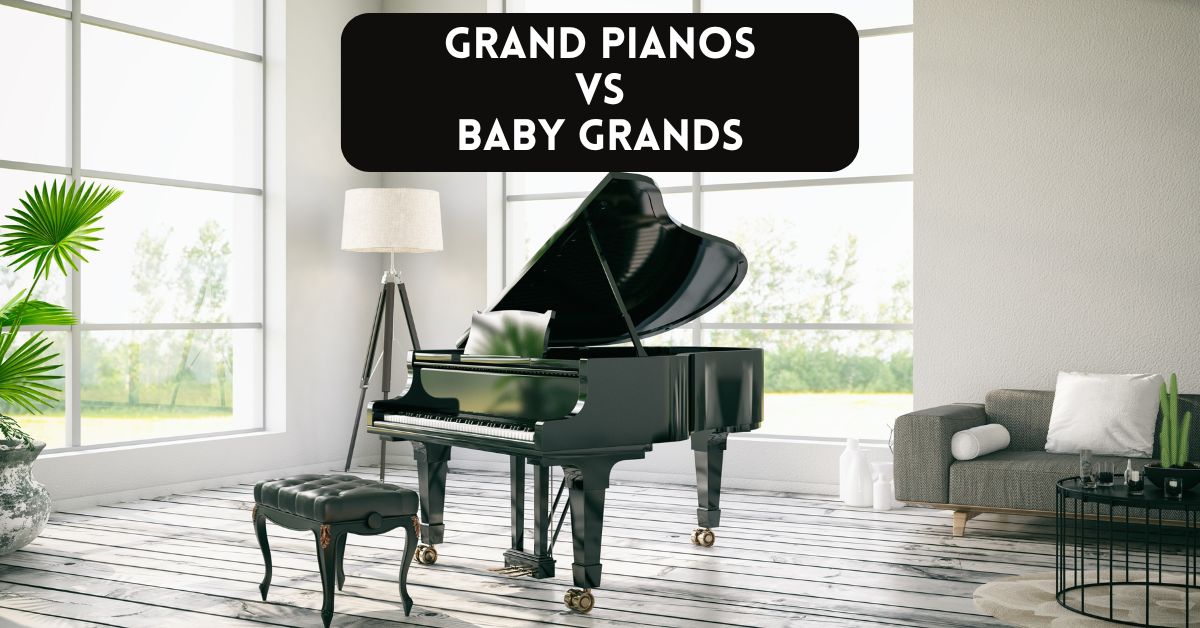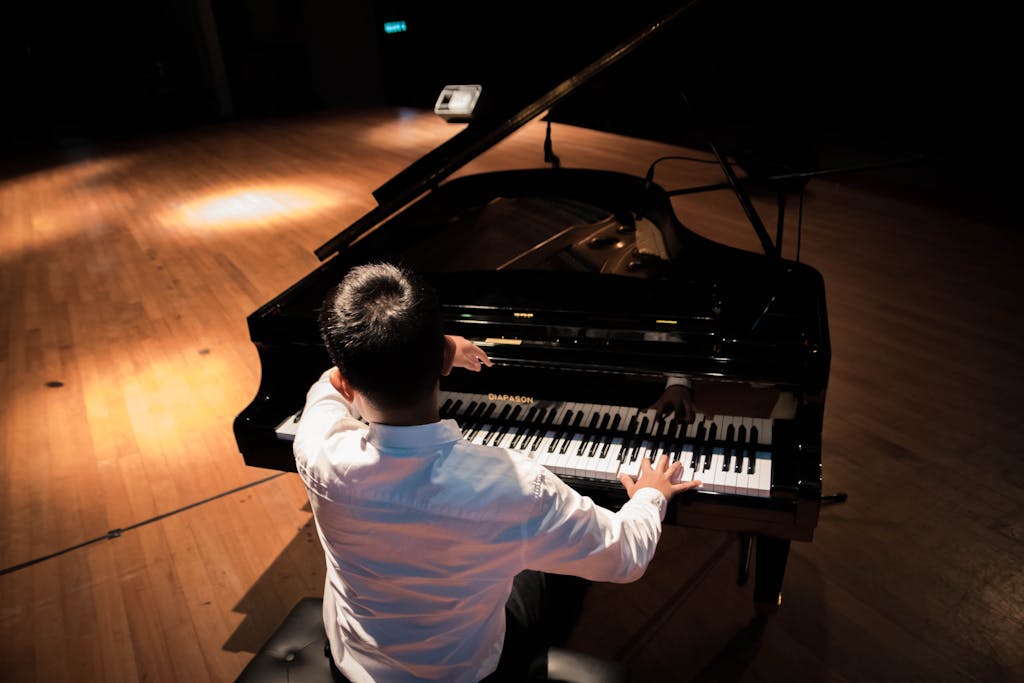When choosing a piano, the decision often narrows to two popular types: grand pianos and baby grand pianos. While both options offer exceptional sound quality and craftsmanship, they differ in size, price, and suitability for various spaces and needs. This grand piano vs baby grand piano guide will help you understand the key distinctions and advantages of each so that you can make an informed decision.
What is a Grand Piano?
A grand piano is the pinnacle of piano design and sound. Known for its full and rich tonal quality, it is a favorite among professional pianists and is typically found in concert halls. Grand pianos typically range in size from 6 to 9 feet in length, with the largest models being concert grand pianos.
Key Features of Grand Pianos:
- Sound Quality: The longer strings and larger soundboard produce a deep, resonant sound.
- Design: The horizontal design allows for superior hammer and string mechanics, resulting in better control and responsiveness.
- Uses: Ideal for large venues, professional studios, and serious pianists.
What is a Baby Grand Piano?
A baby grand piano is a smaller version of the grand piano, offering similar design and tonal characteristics but in a more compact size. Baby grands typically range from 4’ 6” to 5’ 6” in length, making them a popular choice for homes and smaller spaces.
Key Features of Baby Grand Pianos:
- Sound Quality: While not as powerful as a full grand, baby grands still deliver excellent tonal quality.
- Design: Retains the elegant appearance of a grand piano but in a smaller footprint.
- Uses: Ideal for home settings, small performance spaces, and casual musicians.
Main Differences Between a Grand Piano and Baby Grand Piano
While both types share similar mechanics and aesthetic appeal, the primary differences come down to size, price, and overall quality:
Size and Space Requirements
- Grand Piano: The main difference between the full-size grand piano and its baby grand cousin is piano sizes. The grand piano is larger and requires more room, making it suitable for spacious environments.
- Baby Grand Piano: More compact and better suited for smaller living spaces.
Sound Projection
- Grand Piano: Offers superior projection, richer sound, and tonal depth due to its larger soundboard and longer strings.
- Baby Grand Piano: Produces quality sound but with less projection and resonance than a grand piano.
Price Differences Between a Grand Piano and Baby Grand Piano
- Grand Piano: Generally more expensive, with prices ranging from $20,000 to $150,000 or more depending on the brand and model.
- Baby Grand Piano: More affordable, with prices typically ranging from $10,000 to $30,000, making it a budget-friendly option for many buyers.
Advantages of Grand Pianos
Grand pianos are the gold standard for those seeking the ultimate piano experience. Here are some of their key advantages:
- Superior Sound: The larger size and extended strings allow for unparalleled tonal richness and dynamic range.
- Professional Appeal: Preferred by concert pianists and experienced musicians for their expressive capabilities.
- Prestigious Aesthetic: A full-size grand piano makes a bold statement in any space and adds an air of sophistication.
- Responsive Touch: The actions found on grand pianos provide the most responsive touch compared to other varieties of pianos.
Advantages of Baby Grand Pianos
Baby grand pianos are particularly suited for small spaces and rooms with space constraints. For those who want the beauty and quality of a grand piano in a smaller size, more accessible package, baby grands offer several benefits:
- Compact Size: Fits comfortably in smaller rooms without compromising too much on sound quality. The size difference may be a key driver for smaller venues and private homes with limited space.
- Affordability: A more cost-effective option for those on a budget.
- Versatility: Ideal for casual musicians and home use while still providing an impressive aesthetic.
Disadvantages of Baby Grand Pianos
While baby grand pianos offer several advantages, they also come with certain drawbacks compared to their full-size counterparts. One of the primary disadvantages is the reduction in sound quality and projection. Due to their smaller size, baby grand pianos lack the deep resonance and volume of a full-size grand, which can be a significant difference for professional musicians and serious hobbyists who prioritize acoustic excellence. Additionally, the shorter strings and smaller soundboard may limit the dynamic range and tonal richness, which are crucial for more complex and expressive musical pieces.
Another drawback is that, while generally more affordable, baby grand pianos still require a significant investment and maintenance commitment. Their smaller size can also mean limited placement options for optimal sound performance in some spaces, leading to potential compromises in the acoustic environment. While they offer aesthetic appeal and are suitable for casual use, those seeking the full experience of a grand piano’s capabilities might find the baby grand lacking.
Additional Considerations
When choosing between a grand piano and a baby grand, keep these factors in mind:
- Space Availability: Measure your room carefully to ensure the piano fits comfortably without overwhelming the space.
- Intended Use: Consider your skill level, frequency of use, and whether the piano is for professional or personal enjoyment.
- Resale Value: Grand pianos tend to hold their value better over time than baby grands.
- Acoustic Environment: Larger rooms may benefit from the sound projection of a grand piano, while smaller spaces may not allow a grand to reach its full potential.
- Skill Level: Advanced players will appreciate the rich sound and features of a quality grand piano which offers greater control than most keyboard alternatives.
Other Alternative Piano Options
Upright Pianos
The Upright Piano is an excellent alternative to a baby grand, especially when space and budget are significant considerations. Unlike the larger grand pianos, these vertical pianos are designed to fit seamlessly against a wall, making them ideal for smaller rooms or apartments where space is at a premium. Despite their compact size, upright pianos can still deliver rich, resonant tones and a satisfying playing experience that meets the needs of both novice and seasoned musicians.
One of the key advantages of an upright piano is its affordability. Generally, upright pianos are less expensive than baby grand, providing excellent value without compromising on sound quality or durability. This makes them a practical choice for families, schools, or music enthusiasts who want the benefits of a piano without the hefty price tag associated with grand models.
Additionally, upright pianos are easier to maintain and move. Their vertical design means that moving them through doorways or tight spaces is less cumbersome than with the larger footprint of a baby grand. This can be especially beneficial for individuals who anticipate relocating or rearranging their living spaces.
Overall, the upright piano offers a harmonious blend of economy, space efficiency, and musical capability, making it an appealing choice for those seeking an alternative to the baby grand without sacrificing quality.
Digital Pianos
Digital pianos present a modern alternative to traditional acoustic pianos, including baby grands. They are particularly appealing to tech-savvy musicians, individuals with limited space, or those who require portability. Unlike their acoustic counterparts, digital pianos often come equipped with a variety of features such as different sound settings, recording capabilities, and the option to plug in headphones for silent practice, which can be highly beneficial for apartment dwellers or those with roommates.
For beginners, digital pianos can offer an advantage with built-in tutorials and learning tools. Additionally, their lower weight and compact design make them easier to transport, perfect for musicians who frequently perform at different venues. Some models even mimic the touch and feel of a traditional piano very closely, providing an authentic experience at a fraction of the cost. You’ll also be spared the cost of piano tuners which are required for acoustic pianos.
Overall, digital pianos are an excellent choice for those looking to balance technology with music, offering flexibility and innovation without the commitment to a large permanent fixture like a baby grand.
Conclusion
Both grand and baby grand pianos are excellent choices when comparing types of pianos. Each has unique strengths to suit different needs and preferences. If you’re seeking top-tier sound and have the space and budget, a grand piano is the way to go. A baby grand is an ideal choice for those looking for a more compact, affordable option that still delivers impressive performance. Don’t forget to consider upright pianos and digital pianos when deciding which is the best option for you. Ultimately, the right piano for you will depend on your specific requirements and aspirations.


